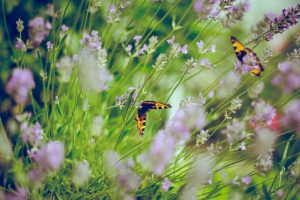Utah is home to 900 amazing and diverse native bees. They are proficient and essential pollinators. Compared to honey bees, native bees are better at pollinating apple, squash, melon, tomatoes and native plants. Unfortunately, native bee populations are in decline due in part to habitat loss and pesticide use. You can make a difference by supporting a native bee population right in your own backyard.
Provide Sources of Nectar and Pollen
It’s important to supply nectar and pollen from early spring, as soon as bees become active, through late fall. You should incorporate native plants as much as possible. Native bees have evolved with native plants for thousands of years and are mutually adapted to each other.
- Consider letting some clover, violets or fleabane creep into your lawn.
- Plant flowers in blocks, several of the same type grouped together.
- When choosing non-native plants, avoid double petal flowers, highly selected cultivars, and hybrids as they are generally poor sources of nectar and pollen.
- Native plant lists can be found on our website or at the USU Extension.
Provide Nesting Sites
Many native bees nest in the ground and only require a bare patch of soil in a sunny location that won’t be disturbed. Some bees use mud to build their nests so an available mud patch is appreciated. Many bees nest in tree snags, a hub of biodiversity given they pose no hazard. You can also buy or build bee houses. Directions for building a bee house for native bees can be found Xerces Society or at Green Bean Connection.
To shop bee houses and supplies visit Crown Bees for an extensive selection.
Provide Water
Provide clean shallow water that is easy to get in and out of. A gently sloped rock placed in a bird bath or saucer works well. This helps our local butterflies too! You can read more butterflies in our Butterfly Blog.
Go Pesticide Free
Tolerate some damage to plants as part of a greater ecology which often balances itself out beautifully without pesticide intervention.
For more information on these fascinating creatures, the USDA Forest Service has some good information. Or you can read up at Pollinator.
Other useful links and resources:
How to Find Flowers for Your Garden that Do Not Attract Bees

